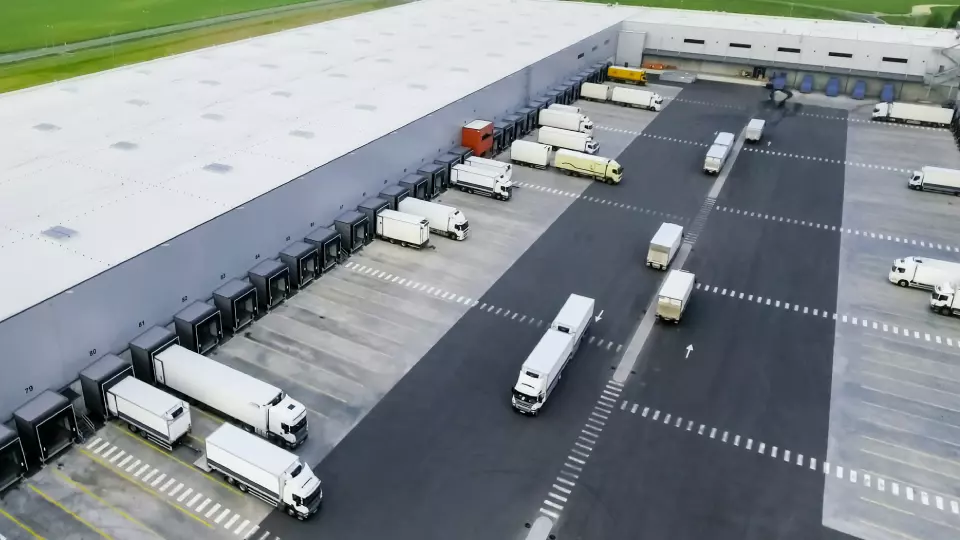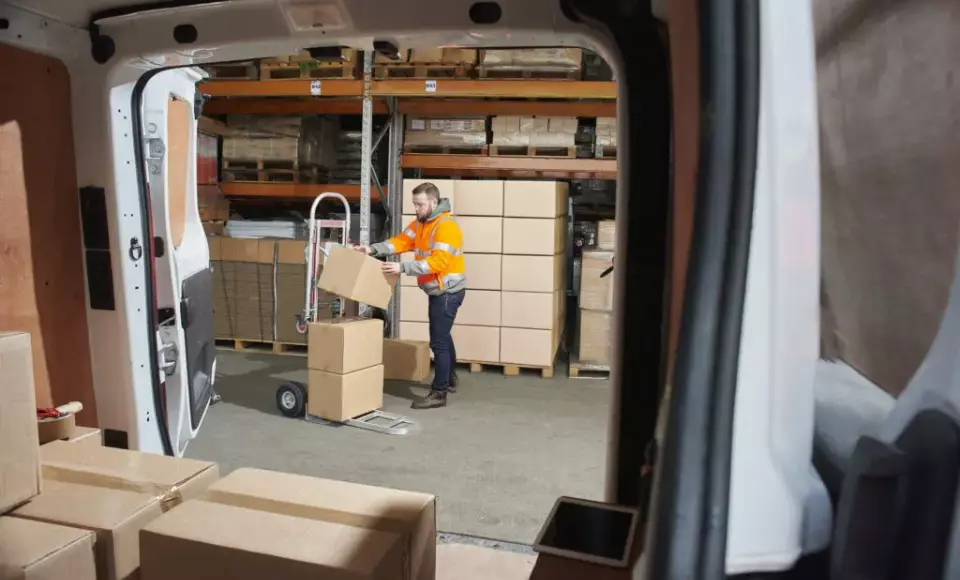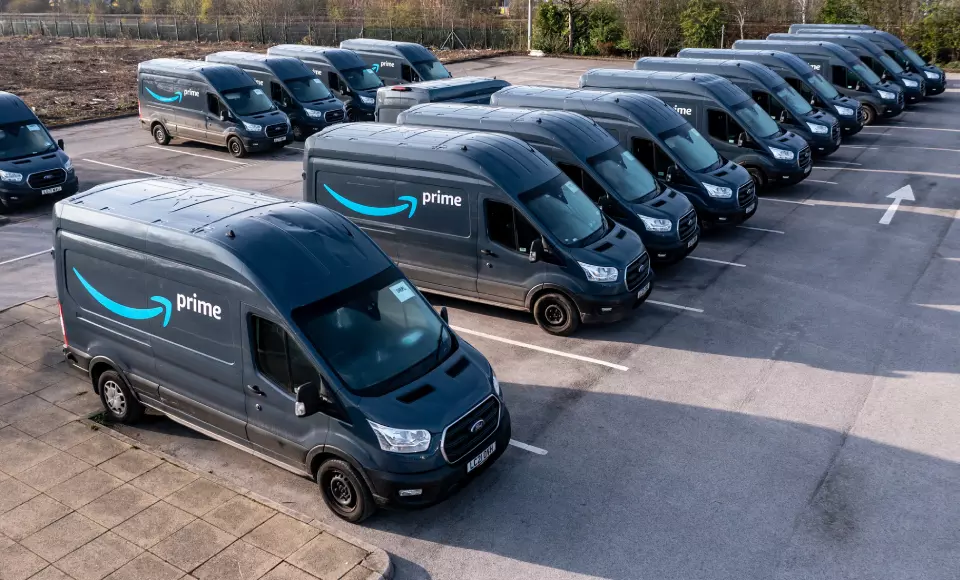The continuous rise of eCommerce and logistics technologies has simplified, streamlined, and accelerated the distribution of goods on a global scale. According to Allied Market Research, the eCommerce logistics market is growing at a compound annual growth rate (CAGR) of 23.5% and is set to reach $1.9 trillion by 2030.
The industry owes most of its success to the sophisticated, ever-evolving supply chain infrastructure comprising various supply chain elements, integrated processes, and transport mediums that work collectively to move products from sellers to buyers.
One of the most important aspects in the logistics industry is last-mile delivery – the last leg or movement of a product’s transportation from the warehouse, often a distribution center, to the customer’s doorstep.
In this article, we’ll explain in detail what last-mile delivery is, how it works, and the vehicles used to support final deliveries. We’ll also talk about the key challenges shippers and carriers face, and share some of the technologies and solutions used to overcome them.
What Is Last-Mile Delivery?
Last-mile delivery refers to the final leg of a shipment, following which the recipient receives their items and the shipper marks the delivery as completed. The last-mile process begins when the goods have completed most of their journey and have reached the final facility, which is typically a distribution center or a warehouse.

In this facility, the goods are temporarily stored, until they are scheduled and loaded into smaller freight vehicles for the final delivery. Like any supply chain process, last-mile deliveries consist of order processing, inventory management, and transportation coordination.
These processes aim to bridge the gap between the distribution center and the receiver’s location to improve delivery speed, accuracy, success rate, and customer satisfaction.
As a result, eCommerce, retail, food delivery, and other companies that rely on last-mile deliveries employ different strategies and solutions to overcome the challenges in each process, reduce their costs, and optimize overall supply chain performance.
How Does Last-Mile Delivery Work?
To help you better understand the concept of last-mile deliveries, we’ve provided an overview with detailed explanations of the entire logistical processes that are involved in this process.
- Order Processing – The shipper (typically the seller) receives an order for a product. Upon payment verification, the order is processed by the warehouse or fulfillment team.
- Picking – The item is picked and packed from the warehouse and prepared for shipping. This process also involved packing & labeling.
- Consolidating – The order is then consolidated with other orders and segregated based on priority, location, route, and various other factors.
- Dispatching – Once the orders are sorted, scheduled, and ready for delivery, the dispatching team loads them into the respective delivery vehicles.
- Transporting – Next, the loaded vehicles transport the orders to relay delivery locations, such as regional distribution centers or sea/airports (for international orders).
- Customs Clearance (for International Shipments) – International orders undergo customs clearance, including duty/tax payment, document verification, and inspection.
- Cross-Docking – Cross-docking is an important process in global supply chains and revolves around the concept of temporarily sorting, segregating, and transferring goods from a distribution center into freight vehicles for the final delivery.
- Scheduling – If the orders end up in a distribution center, the logistics team plans last-mile delivery routes based on factors like delivery date & time, location, and traffic conditions.
- Last-mile delivery – After orders have been scheduled for delivery, they are loaded into delivery vehicles and sent to the final delivery location.
- Receiving – The process concludes once the recipient receives their order and acknowledges package receipt through a signature or other means.
Common Last-Mile Delivery Vehicles
Since a large part of last-mile deliveries are scheduled for individual orders, most service providers generally use smaller freight vehicles instead of larger semi-trucks. Below, you’ll find some of the most common last-mile delivery vehicles.
| Mode of Transport | Description |
| Trucks & Vans | Large vehicles used for last-mile deliveries typically include box trucks and vans. These vehicles have ample storage space and can therefore move a large number of goods in a single trip across long distances for single or multiple deliveries. Due to their larger size and great maneuverability, these vehicles can transport large and odd-shaped cargo. |
| Cars | Many carriers use personal or company-owned vehicles for smaller-scale last-mile deliveries. These vehicles can easily navigate through high-traffic areas carrying smaller loads. They’re also excellent for time-sensitive deliveries and shipping small packages (8.6 x 5.4 x 1.6 in) or up to 70 lbs. |
| Motorcycles | Two-wheeled motorized vehicles like motorcycles and scooters are excellent for quick and frequent last-mile deliveries. They can easily navigate through traffic better than cars and complete deliveries faster. They’re generally used by food and courier services operating in congested urban areas. |
| Bicycles | Delivery bicycles have been used for decades to make last-mile deliveries, such as newspapers, small packages, and food. These human-powered vehicles are more economical, eco-friendly, and excellent for short-distance shipments, usually within a five-mile radius. Additionally, bikes provide more agility due to the ease of parking and convenient access. |
| On Foot | On-foot last-mile deliveries are popular in densely populated urban centers, business hubs, and pedestrian-only zones. Many carriers employ personnel to make small-scale deliveries, usually within a one-mile radius of distribution centers. |
Last-Mile Delivery Challenges & Problems
Last-mile deliveries are among the most complex logistics activities in the supply chain industry, due to time sensitivity, capacity, costs, resource requirements, and various other factors.

Shippers and last-mile service providers have to overcome numerous hurdles and challenges to complete deliveries successfully and reliably. Below, we explore some of the most impactful challenges and problems that they face.
Speed
Modern consumers are accustomed to fast delivery times. Hence, shippers and last-mile service providers must meet their expectations while dealing with difficulties at different touchpoints in their value chain.
From traffic congestion to unpredictable road conditions, order damage, and driver unavailability, several issues can cause unwanted delays in delivery times. As a result, companies must ensure efficient routing and devise contingencies to meet their delivery KPIs.
Capacity
Delivering multiple shipments to different customer addresses requires precise planning and coordination, especially during peak periods. Loads should be optimized for each freight vehicle and drivers need to be efficiently utilized and rotated to handle large shipment volumes successfully.
For instance, a fully loaded truck of small packages may result in incomplete deliveries due to frequent handling and would be better handled by multiple smaller freight vehicles instead.
Many last-mile delivery companies struggle with seasonal volume fluctuations, as they lead to bottlenecks and potential delays. Companies try to offset this by increasing labor, using digital fulfillment solutions and platforms, and streamlining operational processes.
Coverage
Retailers, eCommerce stores, and other companies offering delivery services are often required to ship to remote or hard-to-access areas. As a result, logistics companies have to adjust their strategies, route planning, and timings to ensure successful deliveries while avoiding delays and losses.
It goes without saying that managing urban and rural deliveries can be difficult, especially if they don’t have the resources, equipment, and digital solutions to streamline their processes.
In efforts to facilitate a large area of coverage, last-mile service providers often expand and upgrade their delivery fleets and distribution centers.
Cost
Last-mile providers have to manage both capital expenditures (CapEx) and operational expenditures (OpEx). Capital expenditures include office buildings, distribution centers, IT infrastructure, digital solutions, fleets (trucks, vans, etc.), and licenses, to name a few.
Similarly, operational expenses include rent, labor, fuel, vehicle maintenance, packaging and handling, insurance premiums, and reverse logistics for returns and exchanges.
Controlling these expenses and adjusting processes to rising costs requires continuous cost planning and effective resource management, which some companies may find hard to manage. They must also balance costs and profits to offer customers competitive pricing.
Coordination
Another challenge is coordinating deliveries and schedules between multiple parties including, consignees, drivers, agents, partners, warehouse staff, and more. Effective coordination is required to optimize routing and delivery times between multiple deliveries.
However, managing multiple service providers and integrating their processes requires extensive supply chain expertise and a mix of comprehensive solutions to enable visibility into the value chain.
Liability
Last-mile deliveries are not without risks and liabilities, including, package damage, theft, or loss during transit. Both shippers and carriers must be able to handle liability issues related to delays, accidents, and injuries to ensure compliance with regulatory bodies and safety standards. The more complex the supply chain, the more difficult it becomes to identify and mitigate these risks.
Security
Facilities are susceptible to security breaches like unauthorized access, tampering with cargo, and even theft. It is estimated that cargo theft costs transport companies and retailers up to $30 billion a year.
The physical nature of freight transport leaves cargo in the control of third parties like delivery partners. Shippers are not always able to guarantee packages will reach customers in their original condition as the assets and facilities of service providers may get compromised.
Moreover, packages can be easily lost during transit due to inadequate tracking systems and ineffective loading practices. Furthermore, all stakeholders involved in last-mile deliveries also deal with cybersecurity threats that can disrupt the supply chain and lead to sensitive information and cargo being compromised.
Many last-mile providers that are partnered with third-party companies typically take extra precautions to safeguard shipments at every touchpoint by employing robust compliance policies and security measures.
Customer Satisfaction
Customer expectations are ever-evolving as we venture into a digital-first economy. Last-mile deliveries are arguably the most complex leg of the shipping process due to time sensitivity and complex logistics arrangements.
Issues such as delays or cargo damage can directly impact customer experience. Shippers and delivery partners spend a considerable amount of time navigating around challenges like traffic congestion, accidents, and other potential delays by employing live-tracking technologies.
Even though most companies have business continuity plans (BCP), it’s only a matter of time before issues arise in the world of supply chain. Therefore, these companies establish reliable communication channels to handle customer concerns, complaints, and feedback.
Return Logistics
Return logistics deals with product returns from customers that get sent back to the seller and requires last-mile logistics providers to pick up the product, and conduct inspections and either restocking or disposing of it.
While return logistics is often a complex activity, it remains a necessary aspect of last-mile delivery, especially for e-commerce or retail products that have return policies.
The challenge in return logistics is that delivery partners are tasked to coordinate and manage return pickups from customers. They are required to carry out all the processes they completed initially in reverse order.
Many service providers have physical drop-off locations or centers to lower the risk of overutilizing their fleet. Having such facilities reduces the use of extra resources, such as fuel, labor, and time, to pick up packages from customers physically.
Another challenge of return logistics is unpredictable and inconsistent return rates that can impact resource allocation, costs, and process efficiency. To overcome these challenges, companies implement robust return policies and implement software and tools to streamline processes.
Last-Mile Delivery Technologies & Solutions
Last-mile delivery requires precise planning, optimal routing, effective communication, and a streamlined supply chain to ensure fast and reliable service while reducing operational costs.
A reliably last-mile delivery network can be further improved with technologies and solutions, which we’ll touch on in the section below.
Dedicated Delivery Fleet
Many eCommerce, fast-moving consumer goods (FMCG), and retail companies like Amazon and PepsiCo have their own delivery vehicles that include trucks, vans, and other types.

An in-house fleet handling the last leg of deliveries can help meet time-sensitive demands, provide better routing and scheduling control, and expedite deliveries. A versatile fleet with multiple vehicle types offers more flexibility regarding routes, timing, and road conditions.
Additionally, it can enhance delivery capacity and availability, allowing businesses to improve customer satisfaction. From an environmental viewpoint, they can reduce their carbon footprint by customizing their fleet with alternative fuel options.
Third-Party Vendors
Third-party vendors that provide last-mile delivery services are typically trucking companies, couriers, and other logistics providers. Outsourcing these activities to a third party gives companies more flexibility and scalability.
With access to a wide pool of delivery vehicles and vast network coverage, they can easily outsource last-mile deliveries and leverage third-party infrastructure and expertise.
However, as mentioned earlier, working with multiple vendors requires integrating various systems to enable synchronous and asynchronous communication between all parties involved.
Crowdsourcing
The eCommerce and retail industry has been at the forefront of utilizing independent contractors and individuals specializing in different supply chain activities, including last-mile deliveries.
This solution is typically referred to as crowdsourcing whereby freelancers complete the last leg of deliveries using their personal vehicles. This gives companies the ability to leverage in-house or third-party crowdsourcing apps and platforms to find resources to perform deliveries.
The practice is common in locations where businesses don’t have their own logistics infrastructure such as restaurants and small-scale artisans, or larger businesses with limited facilities and resources.
Once orders are ready for delivery, delivery contractors will start bidding for the transport assignment. Certain crowdsourced transportation platforms allow companies to select contractors, whereas others will automatically assign the nearest or most suitable one.
Once they are assigned, they pick up the order from the distribution center and deliver the product to the final destination. Crowdsourcing last-mile deliveries is also an innovative option to satisfy excess delivery demands by temporarily increasing capacity.
Transportation Management Systems
A transport management system (TMS) is an advanced logistics platform that can help businesses digitize their supply chain processes and optimize the physical movement of goods from their facilities to customers.

Innovative transport management systems can significantly improve last-mile deliveries through route planning optimization, faster delivery times, and enhanced visibility from real-time tracking.
With all touchpoints (vendors, drivers, etc.) connected through a centralized digital hub, businesses can enable automated workflows to reduce administrative burdens and improve performance in every process, including load balancing, resource allocation, fleet utilization, and more.
Warehouse Management Systems
A warehouse management system (WMS) is a software solution that retail, manufacturing, and shipping companies use to digitize warehouse administration and inventory management.
It can improve last-mile deliveries by digitizing, automating, and streamlining order fulfillment and stock management. Warehouse management systems maintain accurate inventories that help simplify order processing, packaging, and shipping, reducing the dispatch time significantly.
It can also improve coordination between warehouse and delivery teams by providing more visibility over processes and centralizing communication, making last-mile deliveries more efficient.
Enterprise Resource Planning Systems
Enterprise Resource Planning (ERP) systems are business management solutions used to manage core processes, including accounting, operational management, and supply chain.
This software can significantly improve last-mile deliveries by integrating data from multiple systems and departments, including inventory, transport, sales, finance, and more. ERPs enhance visibility and coordination at each touchpoint, allowing order fulfillment teams to optimize packaging, routing, and tracking for faster last-mile deliveries.

Get Free Course Access
If you enjoyed the article, don’t miss out on our free supply chain courses that help you stay ahead in your industry.

Andrew Lin
Co-Founder & Writer
at freightcourse
About the Author
Andrew is a multi-business owner with over 12 years of experience in the fields of logistics, trucking, manufacturing, operations, training, and education.
Being the co-founder of freightcourse has given him the ability to pursue his desire to educate others on manufacturing and supply chain topics.
Follow us